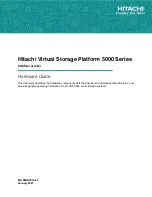
18
Cheetah NS 10K.2 SAS Product Manual, Rev. B
the interval expires, the error rate is considered to be unacceptable. If the number of errors does not exceed
the threshold before the interval expires, the error rate is considered to be acceptable. In either case, the inter-
val and failure counters are reset and the process starts over.
Predictive failures
S.M.A.R.T. signals predictive failures when the drive is performing unacceptably for a period of time. The firm-
ware keeps a running count of the number of times the error rate for each attribute is unacceptable. To accom-
plish this, a counter is incremented each time the error rate is unacceptable and decremented (not to exceed
zero) whenever the error rate is acceptable. If the counter continually increments such that it reaches the pre-
dictive threshold, a predictive failure is signaled. This counter is referred to as the Failure History Counter.
There is a separate Failure History Counter for each attribute.
5.2.6
Thermal monitor
Cheetah drives implement a temperature warning system which:
1. Signals the host if the temperature exceeds a value which would threaten the drive.
2. Signals the host if the temperature exceeds a user-specified value.
3. Saves a S.M.A.R.T. data frame on the drive which exceeds the threatening temperature value.
A temperature sensor monitors the drive temperature and issues a warning over the interface when the tem-
perature exceeds a set threshold. The temperature is measured at power-up and then at ten-minute intervals
after power-up.
The thermal monitor system generates a warning code of 01-0B01 when the temperature exceeds the speci-
fied limit in compliance with the SCSI standard. The drive temperature is reported in the FRU code field of
mode sense data. You can use this information to determine if the warning is due to the temperature exceeding
the drive threatening temperature or the user-specified temperature.
This feature is controlled by the Enable Warning (EWasc) bit, and the reporting mechanism is controlled by the
Method of Reporting Informational Exceptions field (MRIE) on the Informational Exceptions Control (IEC)
mode page (1Ch).
The current algorithm implements two temperature trip points. The first trip point is set at 68°C which is the
maximum temperature limit according to the drive specification. The second trip point is user-selectable using
the Log Select command. The reference temperature parameter in the temperature log page (see Table 11)
can be used to set this trip point. The default value for this drive is 68°C, however, you can set it to any value in
the range of 0 to 68°C. If you specify a temperature greater than 68°C in this field, the temperature is rounded
down to 68°C. A sense code is sent to the host to indicate the rounding of the parameter field.
5.2.7
Drive Self Test (DST)
Drive Self Test (DST) is a technology designed to recognize drive fault conditions that qualify the drive as a
failed unit. DST validates the functionality of the drive at a system level.
There are two test coverage options implemented in DST:
1. Extended test
2. Short text
Table 11:
Temperature Log Page (0Dh)
Parameter Code
Description
0000h
Primary Temperature
0001h
Reference Temperature
Summary of Contents for CHEETAH NS 10K.2 ST3450802SS
Page 1: ...Product Manual Cheetah NS 10K 2 SAS 100516228 Rev B July 2009 ST3600002SS ST3450802SS ...
Page 6: ...2 Cheetah NS 10K 2 SAS Product Manual Rev B ...
Page 10: ...6 Cheetah NS 10K 2 SAS Product Manual Rev B ...
Page 14: ...10 Cheetah NS 10K 2 SAS Product Manual Rev B ...
Page 26: ...22 Cheetah NS 10K 2 SAS Product Manual Rev B ...
Page 38: ...34 Cheetah NS 10K 2 SAS Product Manual Rev B ...
Page 46: ...42 Cheetah NS 10K 2 SAS Product Manual Rev B ...
Page 79: ......
















































